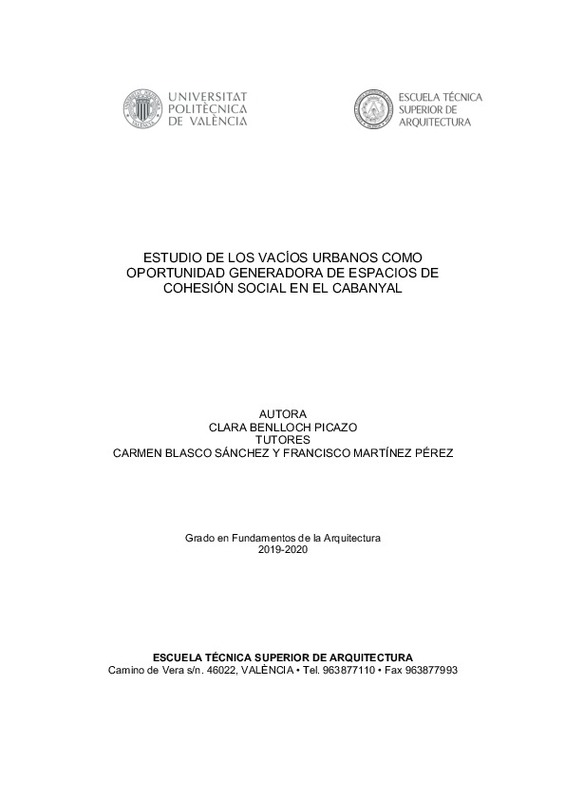JavaScript is disabled for your browser. Some features of this site may not work without it.
Buscar en RiuNet
Listar
Mi cuenta
Estadísticas
Ayuda RiuNet
Admin. UPV
Estudio de los vacíos urbanos como oportunidad generadora de espacios de cohesión social en el Cabanyal
Mostrar el registro sencillo del ítem
Ficheros en el ítem
| dc.contributor.advisor | Martínez Pérez, Francisco Juan
|
es_ES |
| dc.contributor.advisor | Blasco Sánchez, María del Carmen
|
es_ES |
| dc.contributor.author | Benlloch Picazo, Clara
|
es_ES |
| dc.coverage.spatial | east=-0.3301342; north=39.46785959999999; name=El Cabanyal, València, Valencia, Espanya | es_ES |
| dc.date.accessioned | 2020-01-20T11:13:06Z | |
| dc.date.available | 2020-01-20T11:13:06Z | |
| dc.date.created | 2019-09-19 | |
| dc.date.issued | 2020-01-20 | es_ES |
| dc.identifier.uri | http://hdl.handle.net/10251/135115 | |
| dc.description.abstract | [ES] En el presente trabajo se pretende destacar el papel de los vacíos urbanos y espacios industriales abandonados en el Cabanyal (Valencia), como incentivo para la rehabilitación y revitalización del barrio. Se trata de poner de manifiesto la diversidad cultural que actualmente existe y dar expresión y visualizar la importancia de un espacio compartido de cohesión para el vecindario, enfrentado a una pérdida de identidad ante la inminente gentrificación. El trabajo se centra en la franja que separa la trama reticular origen del barrio de su límite oeste. En concreto, en los vacíos de la Calle Lluís Despuig y las industrias abandonadas que allí se encuentran, haciendo uso de este contexto como lugar estratégico para la dinamización del espacio y el fomento de su uso por parte de la comunidad, que no limiten el ocio al consumo y al turismo. | es_ES |
| dc.description.abstract | [EN] This paper aims to highlight the role of urban voids and abandoned industrial spaces in the Cabanyal (Valencia), as an incentive for the rehabilitation and revitalization of the neighborhood. The aim is to reveal the cultural diversity that currently exists and to express and visualize the importance of a shared space of cohesion for the neighborhood, faced with a loss of identity in light of the imminent gentrification. The work focuses on the strip that separates the reticular grid origin of the neighborhood from its western boundary. Expressly, in the voids of Lluís Despuig street and the abandoned industries that are there, making use of this context as a strategic place for the invigoration of space and the promotion of its use by the community, which does not limit leisure to consumption and tourism. | es_ES |
| dc.language | Español | es_ES |
| dc.publisher | Universitat Politècnica de València | es_ES |
| dc.rights | Reserva de todos los derechos | es_ES |
| dc.subject | Cabanyal-Canyamelar (Valencia, Barrio) | es_ES |
| dc.subject | Urban regeneration | es_ES |
| dc.subject | Regeneración urbana | |
| dc.subject | Derecho a la ciudad | |
| dc.subject | Urbanismo | |
| dc.subject | Asociacionismo | |
| dc.subject | Social cohesion | |
| dc.subject | Associationism | |
| dc.subject | Urbanism | |
| dc.subject.classification | URBANISTICA Y ORDENACION DEL TERRITORIO | es_ES |
| dc.subject.other | Grado en Fundamentos de la Arquitectura-Grau en Fonaments de l'Arquitectura | es_ES |
| dc.title | Estudio de los vacíos urbanos como oportunidad generadora de espacios de cohesión social en el Cabanyal | es_ES |
| dc.type | Proyecto/Trabajo fin de carrera/grado | es_ES |
| dc.rights.accessRights | Abierto | es_ES |
| dc.description.bibliographicCitation | Benlloch Picazo, C. (2019). Estudio de los vacíos urbanos como oportunidad generadora de espacios de cohesión social en el Cabanyal. http://hdl.handle.net/10251/135115 | es_ES |
| dc.description.accrualMethod | TFGM | es_ES |
| dc.relation.pasarela | TFGM\114302 | es_ES |
Este ítem aparece en la(s) siguiente(s) colección(ones)
-
ETSA - Trabajos académicos [4687]
Escuela Técnica Superior de Arquitectura






